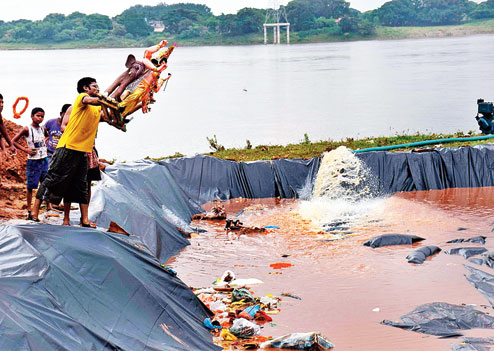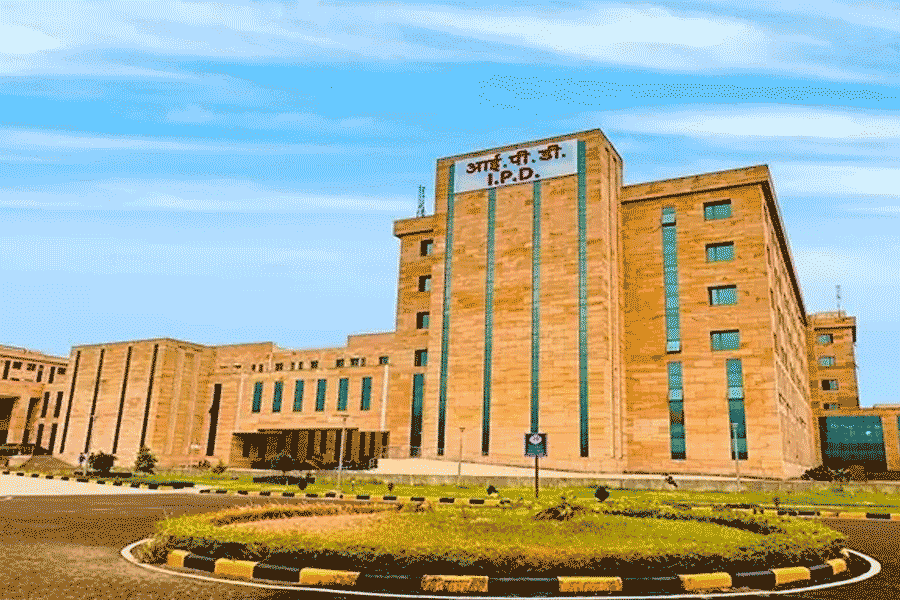FESTIVITIES WITHOUT POLLUTION

Bhubaneswar/Cuttack, Sept. 28: The bright colours of idols have for long been leaving a polluting impact on rivers and local water bodies. But all that has begun to change with municipal corporations in the twin cities digging up temporary ponds for immersion of idols.
It is not that the municipal corporations in Bhuban-eswar and Cuttack have acted spontaneously. It only happened after Orissa High Court ordered one of the civic bodies to construct temporary ponds for immersion of idols to minimise the level of pollution.
The high court on September 15 ordered the Cuttack district administration and the civic body to make temporary arrangements for the immersion of idols to fight water pollution.
However, the high court order should be seen in light of a Bombay High Court directive issued to the Centre on July 22, 2008.
In its 2008 order, the high court had directed the central government to lay down guidelines for idol immersion to check river water pollution.
Consequently, the Central Pollution Control Board issued relevant guidelines for immersion of idols as already the river pollution level had become a threat to the environment.
The biggest threat to water remains the use of artificial colours on idols.
Sources in the state pollution board said that toxic chemical colours being used to make the idols polluted the water bodies.
The immersion of idols also deteriorates the water quality in respect of conductivity and biochemical oxygen demand because of a high concentration of heavy metals.
To ensure that water bodies are not polluted and to implement the September 15 directive of Orissa High Court, the civic body in Cuttack, as well as its counterpart in Bhuban-eswar, took several steps prior to the immersion of Vishwakarma and Ganesh idols.
While the Bhubaneswar Municipal Corporation has dug three temporary ponds on the beds of two rivers for idol immersion, its Cuttack counterpart has similar facilities at Khannagar, Debi Ghat and Cantonment.
In Bhubaneswar, two ponds have been dug on the Kuakhai river bed - one near the Hanspal bridge on the NH-5 and another near Balianta. The third pond has been constructed on the Daya river bed near Dhauli on the Bhubaneswar-Puri road.
"The three ponds will check river pollution during the immersion, as members of the Puja committees as well as general public often tend to throw other wastes into the river. Now, they are expected to immerse the idols in these three ponds. Later, the wastes will be fished out to make the water clean," said Bhubaneswar mayor Ananta Narayan Jena.
Last year after the Puja, Jena had said the corporation would take steps to build temporary ponds to reduce pollution of rivers near the city.
On the other hand, city engineer of the Cuttack civic body Umakant Gadnayak said the three trenches, each 57ft deep and 100ft wide, were constructed and 10 sanitary staff members were deployed for removal of the leftover materials within 24 hours of the immersion of Viswakarma and Ganesh idols.
Besides, polythene sheets were used in the trenches to ensure that there was no contamination of the soil and river water.
The temporary ponds saved Mahanadi and Kathajodi rivers from pollution.
Around 750 Ganesh idols of major clubs and Puja committees were immersed at the three sites. Official sources said around 150 Durga idols were expected to be immersed at these ponds on October 2.
An official of the Cuttack civic body also said all the leftover materials such as puja articles, dry flowers, earthen pots and plastic items were subsequently disposed of in a scientific manner at the dumping yard.
Senior engineer of the Bhubaneswar civic body Ashok Kumar Parida said: "We have started using the three ponds and installed proper signage for their easy identification. People have already immersed idols of Lord Ganesh and Lord Vishwakarma in these ponds. We also expect 150 Durga idols to be immersed in these ponds."
Senior environmental scientist Bibekananda Bhol said: "We asked the civic bodies to adopt the measures as the Central Pollution Control Board had laid the guidelines for idol immersion to check river water pollution."
The scientist said: "The artificial colour used in the idols contain elements such as lead, cadmium and nickel, which might cause some carcinogenic effect or toxicity. Other materials such as straw, wood, ply, flowers and plastics, which are associated with idol making, also pollute the river water."
He also said the river pollution could also affect the lifespan of the aquatic flora and fauna as it reduced the oxygen level in the water.
"We are happy that the first-of-its-kind step has been taken to protect the rivers. We hope that the district administration continues to create awareness, and at the same time, ensures that the temporary arrangements are put to use during the immersion of Durga idols next month," said Cuttack resident Kartik Das.
Sources, however, said the idea needed to be replicated by all district administrations to protect water bodies of the state.
GUIDELINES OF CENTRAL POLLUTION CONTROL BOARD
♦ Use natural materials to make idols. Encourage and promote use of traditional clay, instead of baked clay and plaster of Paris
♦ Discourage painting of idols. However, water soluble and non-toxic natural dyes can be used. However, strictly prohibit use of toxic and non-biodegradable chemical dyes for painting idols
♦ Prior to immersion, remove worship materials such as flowers, clothes and those used for decoration (made of paper and plastic). Separately collect bio-degradable materials for recycling or composting
♦ Conduct awareness programme to educate people on ill effects of immersion in water bodies
♦ Cordon off, barricade points of immersion. Much before immersion, place synthetic liner at the bottom of the water body. Remove liner after immersion to take out remains of idols from water
IMPACT ON WATER BODIES
♦ Metals such as mercury, lead and nickel can affect fish and birds and eventually humans through food
SCENARIO IN ODISHA
♦ Officials of Odisha State Pollution Control Board call for awareness among Puja organisers
♦ Last year board collected water sample from Kathajodi in Cuttack and Kuakhai in Bhubaneswar after immersion of Goddess Durga. The samples, however, were much less polluted as compared to standard parameters

COMPILED BY LELIN KUMAR MALLICK











